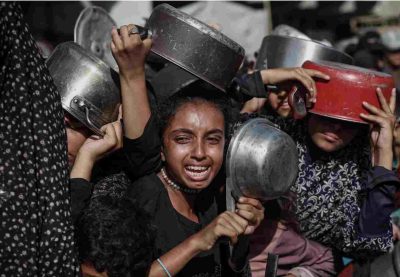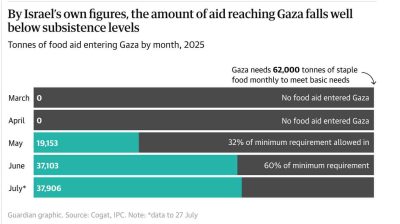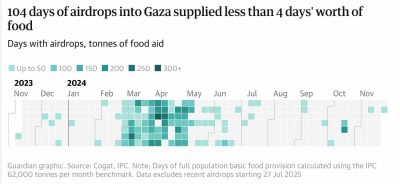
Israel controls the flow of food for Gaza. He calculated how many calories the Palestinians need to stay alive. Your data show that only one fraction has been allowed.
Hunger math is simple in Gaza. Palestinians cannot leave, the war ended with agriculture and Israel forbade fishing, so virtually all the calories its population consumes need to be brought from the outside.
Israel knows how much food is necessary. For decades, Israel has been calibrating hunger in Gaza, initially calculating the shipments to exert pressure while avoiding hunger.
Palestinians crowd at a lentil soup distribution point in the city of Gaza, including children and women holding pans and skillets.
“The idea is to put the Palestinians in diet, but not to make them starve,” said a senior advisor of the then Prime Minister, Ehud Olmert, in 2006. An Israeli court ordered the disclosure of documents showing the details of those macabre sums two years later.
COGAT, an Israeli agency that still controls Gaza’s aid shipping, then estimated that the Palestinians needed a minimum average of 2,279 calories per person per day, which could be supplied by 1,836 kg of food.
Today, humanitarian organizations are asking for even smaller minimum feed: 62,000 tons of dry and canned foods to meet the basic needs of 2.1 million people per month, or about 1 kg of food per person per day.
While Gaza was hungry this summer, Israeli authorities denied the existence of mass hunger, alleged without evidence that Hamas steals and accumulates help, or blamed UN distribution failures by hunger, sharing photos of help pallets waiting for collection inside the border.
They pointed out the deadly and chaotic distributions of food from the Gaza Humanitarian Foundation, a US and Israel -supported logistics startup as proof that Palestinians had access to food.
However, compiled and published data by the Israeli government itself makes it clear that he has made Gaza hungry. Between March and June, Israel allowed the entry of only 56,000 tons of food in the territory, according to Cogat records, less than a quarter of Gaza’s minimum needs in that period.
Even though each UN flour bag had been collected and distributed, and GHF had developed safe systems for equitable distribution, hunger was inevitable. The Palestinians were not enough to eat.
Food security experts supported by the UN said this week that a “worst -case scenario” of hunger is unfolding in Gaza. Food deliveries are “on a much below necessary scale” amid “drastic restrictions on supply entry,” the Integrated Food Safety Phases (IPC) classification in a report that quotes Israeli data on help.
The Hunger Review Committee, an independent expert group that analyzes the IPC alerts, said food shipments “have been highly inadequate” and highlighted the GHF.
“Our analysis of the food packages provided by the GHF shows that its distribution plan would lead to mass hunger, even if it could work without the frightening levels of violence that were reported,” the FrC said.
In March and April, Gaza was in full siege, without food entry. In mid -May, Netanyahu announced that shipments would be resumed due to international pressure on a “hunger crisis.”
 Data compiled and published by the Israeli government itself make it clear that it is killing Gaza with hunger. | Anadolu/Getty Images
Data compiled and published by the Israeli government itself make it clear that it is killing Gaza with hunger. | Anadolu/Getty Images
UN data show that only a few weeks of extra remittances of help during ceasefire in January and February this year provided enough calories to get Gaza out of hunger.
However, in May, only a small amount of foods returned in quantities that only served to slow down Gaza’s hunger, but not to prevent it. Two months later, the scale of suffering triggered another wave of international indignation, including Donald Trump’s demands so that “every gram of food” was delivered to hungry children.

In response, Netanyahu promised only extra “minimal” help. The number of food trucks entering the territory has increased, but is still well below the minimum necessary to feed the Palestinians, much less to reverse a hunger crisis.
 Help packages, launched from an airplane, arrive in Gaza. | Hatem Khaled/Reuters
Help packages, launched from an airplane, arrive in Gaza. | Hatem Khaled/Reuters
The air releases, used intermittently during the war, were also resumed with France, Germany, the United Kingdom, Egypt, Jordan and the United Arab Emirates united among the countries that announced flights, although the launch of food parachutes is expensive, inefficient and sometimes deadly.
Last year, at least 12 people drowned trying to recover foods that fell into the sea, and at least five died when pallets fell on them.
In the first 21 months of war, 104 flights provided the equivalent of only four days of food to Gaza, according to Israeli data, at a cost of tens of millions of dollars. Spending on trucks, the same budget would deliver much more food, but the price of these flights is not just a monetary matter.
They allow Israel and their allies to hunger as a catastrophe caused by logistics, not a crisis created by state politics.
Aerial launches are usually requested as a last resort to feed people in emergency situations, where hostile armed forces or geography make road transport impossible. In Gaza, the only obstacles to transporting help through the border are the restrictions imposed by Israel, coupled with many Western nations, including Britain, and armed with British and American weapons.
Two groups of human rights based in Israel declared this week that Israel was committing genocide in Gaza, with reports citing evidence that includes the transformation of hunger into the weapon. B’TSelem described an official and openly declared policy of mass hunger.

The Israeli government knows how much food the people of Gaza needs to survive and how much food enters the territory and, in the past, used this data to calculate how much food was needed to avoid hunger.
The huge difference between the calories that Gaza needs and the foods that have entered since March makes it clear that Israeli authorities are doing different accounts today. They cannot transfer responsibility for this hunger caused by man to anyone, nor his allies.
Originally published by The Guardian on 07/31/2025
By Emma Graham-Harrison-Middle East Correspondent
Source: https://www.ocafezinho.com/2025/07/31/a-matematica-da-fome-como-israel-causou-fome-em-gaza/

